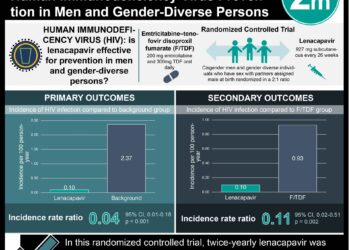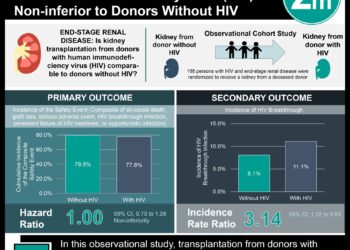Despite regular visits to pediatrician, few adolescent men having sex with men tested for HIV
1. In this study, though many adolescent men who have sex with men (AMSM) reported regularly visiting a physician, a much smaller percentage of them reported being tested for HIV or even having conversations with their physician about same-sex behaviors.
2. Simply having a conversation with their physician about HIV testing was associated with a significant increased rate of HIV testing among AMSM.
Evidence Rating Level: 2 (Good)
Study Rundown: Though early diagnosis and treatment of HIV is key for both the health and wellbeing of the patient affected as well as preventing the spread of disease, little is known about testing behaviors among AMSM, despite high estimated rates of new infections among this population. In this study, researchers surveyed AMSM to investigate whether or not they had been tested for HIV and what factors were associated with having been tested or not. The internet-based survey included a large proportion of participants from racial and/or ethnic minorities and from lower socio-economic backgrounds, the latter being measure by those reporting being on public assistance. Only about one-quarter of participants reported ever having been tested for HIV. Researchers found that many participants had learned about HIV at school, and a much smaller percentage had actually had conversations with their physicians about sexual activity, HIV testing, or their sexual orientation, despite visiting the doctor regularly. Participants that did report having had a conversation with their physician about HIV testing, however, were significantly more likely to have been tested for HIV. In their accompanying commentary, Dr. Errol Fields and Dr. Travis Gayles expressed concern that as many as one-third of participants did not report having a physician they saw regularly, making resources for testing outside the primary care setting vital. Still, this study demonstrates a significantly underutilized resource for screening and testing for HIV, namely that of the primary care visit, which many AMSM reported having attended without having had discussions about HIV. Further investigation is warranted into why primary care physicians are not having such discussions with their adolescent patients.
Click here to read the original article in Pediatrics
Click here to read an accompanying commentaryl
Relevant Reading: Factors Associated With HIV Testing Among HIV-Positive and HIV-Negative High-Risk Adolescents: The REACH Study
In-Depth [survey]: In this study, authors utilized data from SMART, an ongoing, internet-based trial investigating interventions to prevent the spread of HIV among AMSM. Eligible participants were recruited via social media campaigns were required to be between ages 13 to 18 years, assigned male at birth, and report a history of some sexual experience (i.e. genital contact). Participants also had to identify as gay, bisexual, or queer or attracted to cisgender men. A total of 699 individuals completed at least the baseline characteristics portion of the survey, with the mean age of participants being 16.6 (17.3% African American, standard deviation = 1.3 year) There was significant represent representation of racial and/or ethnic minorities (17.3% African American and 31.6% Latinx) as well as individuals from low socio-economic status backgrounds (33.5% on public assistance) among participants. Only one quarter (n = 162, 23.2%) reported ever having been tested for HIV, though significantly more than half (67.5%) reported visiting the doctor regularly. Most participants (66.4%) reported having learned about HIV at school, while a much smaller percent reported having had conversations with their health care provider about sexual behavior with males (21.3%), testing for HIV (19.2%), or their sexual orientation (29.2%). Conversely when assessing the efficacy of various factors influencing participants being tested for HIV, having spoken with a physician about HIV testing was the most potent factor associated with increased rates of testing for HIV (OR = 25.29, 95% CI = 15.91-41.16).
Image: PD
©2020 2 Minute Medicine, Inc. All rights reserved. No works may be reproduced without expressed written consent from 2 Minute Medicine, Inc. Inquire about licensing here. No article should be construed as medical advice and is not intended as such by the authors or by 2 Minute Medicine, Inc.







